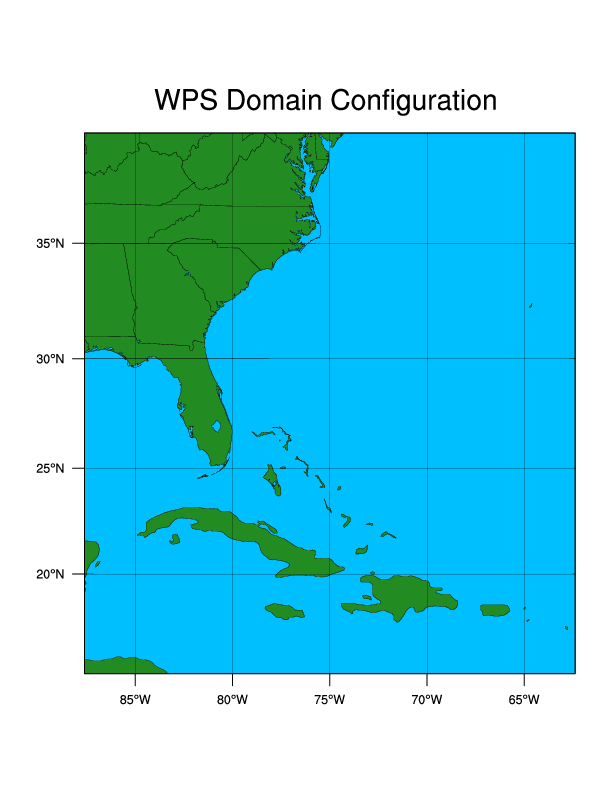Vortex-Following Exercise¶
Vortex-following Option
A WRF configuration that tracks the center of low pressure in a tropical cyclone, and allows the nested domain to move inside the parent to follow the cyclone as it moves.
Tropical cyclones often move across a large area, and when simulating them, a large, high-resolution domain can be computationally expensive. The Vortex Following option uses a large static coarse parent domain, with a nest that moves with the center of low pressure in a tropical cyclone. To use this option, WRF must be compiled with the “vortex-following” nest option, but it uses standard WPS.
Note
The Vortex-following capability only works for tracking cyclones.
Set-up WPS¶
Important
To avoid overwriting files from other exercises, create a dedicated directory to store the geo_em*, met_em*, ungrib output, and namelist.wps.
Move to the /glade/derecho/scratch/$USER/practice_exercises/wps directory.
Use the following information to modify namelist.wps:
Case : Hurricane Matthew, which made landfall as a category 4 hurricane over Haiti, and then weakened before hitting the U.S. coast of South Carolina.
Dates: 2016-10-06_00:00:00 to 2016-10-08_00:00:00
Although you will ultimately process two domains (one parent and one nest), for the WPS process, only configure the parent domain - the only static domain.
Domain size : 91 x 100 grid points
Grid resolution : 27 km
Map projection: mercator - the recommended projection when closer to the equator
To place the domain in the right location on the Earth, make the following additional namelist changes:
ref_lat = 28.00 ref_lon = -75.00 truelat1 = 28.0, stand_lon = -75.00
The following pertains to the meteorological input data:
Type
Global NCEP GFS
Interval
Every 3 hours
Initial Time
2016-10-06_00:00:00
End Time
2016-10-08_00:00:00
Data Directory
/glade/campaign/mmm/wmr/wrf_tutorial/input_data/climate/
File Root
gfs.0p25.2016100600.f0
Vtable
Vtable.GFS
Check the domain’s location, which should be similar to the below image:

Run the WPS executables to create input files for wrf.
Note
Because this case uses a lot of data, NCAR’s HPC system MAY give a segmentation fault when running it with the standard command (
./ungrib.exe) if the login nodes become saturated. To avoid this, use the following (where UMMM0013 is this class’s computing project):qcmd -A UMMM0013 -- ./ungrib.exe
Set-up and Run WRF¶
Move to the /glade/derecho/scratch/$USER/practice_exercises/wrf_vortex/test/em_real directory.
Modify namelist.input to include settings for the static parent domain, and the moving nest (see below), as well as the appropriate dates/times. Domain 01 values should match those from WPS for d01.
&time_control input_from_file = .true.,.false., interval_seconds = 21600 &domains time_step = 150, max_dom = 2, e_we = 91, 88, e_sn = 100, 79, num_metgrid_levels = 32 dx = 27000 dy = 27000 i_parent_start = 1, 25, j_parent_start = 1, 14, parent_grid_ratio = 1, 3, parent_time_step_ratio = 1, 3,
Note
No wrfinput_d02 file will be created since input_from_file is set to .false. for domain 2. This is standard for vortex-following runs.
The d01 **_parent_start* values represent the initial nest location.
Run real and wrf.
Check your output.
Return to the Practice Exercise home to page to run another exercise.
